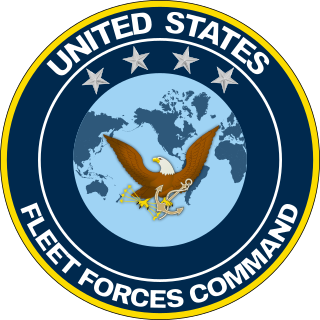Related Research Articles

The United States Fleet Forces Command (USFF) is a service component command of the United States Navy that provides naval forces to a wide variety of U.S. forces. The naval resources may be allocated to Combatant Commanders such as United States Northern Command (USNORTHCOM) under the authority of the Secretary of Defense. Originally formed as United States Atlantic Fleet (USLANTFLT) in 1906, it has been an integral part of the defense of the United States of America since the early 20th century. In 2002, the Fleet comprised over 118,000 Navy and Marine Corps personnel serving on 186 ships and in 1,300 aircraft, with an area of responsibility ranging over most of the Atlantic Ocean from the North Pole to the South Pole, the Caribbean Sea, Gulf of Mexico, and the waters of the Pacific Ocean along the coasts of Central and South America.
Mine Squadron 7, is the designation for a United States Navy minelaying and retrieval command and unit. COMINRON SEVEN was assigned to the United States Pacific Fleet from some time before 1943 until the unit's decommissioning in 1968. The word Commander in the unit's nomenclature refers both the entire unit, the headquarters section, and to the actual commanding officer.

The U.S. Fourth Fleet is a United States Navy numbered fleet. It is the Naval Component Command of U.S. Southern Command (USSOUTHCOM). The Fourth Fleet is headquartered at Naval Station Mayport in Jacksonville, Florida. It is responsible for U.S. Navy ships, aircraft and submarines operating in the Caribbean Sea, and the Atlantic and Pacific Oceans around Central and South America.

USS Shannon (DD-737/DM-25/MMD-25) was a Robert H. Smith-class destroyer minelayer in the United States Navy.

USS Sprig (AM-384) was an Auk-class minesweeper acquired by the United States Navy for the dangerous task of removing mines from minefields laid in the water to prevent ships from passing.

USS Vital (AM-474/MSO-474) was an Agile-class minesweeper in service with the United States Navy from 1955 to 1972. She was sold for scrap in 1979.

Caracara (AMc-40), an Accentor-class minesweeper placed in service by the U.S. Navy for use during World War II. The vessel was named after the Caracara, a large South American bird of prey.

USS Woodcock (AM-14) was an Lapwing-class minesweeper acquired by the United States Navy for the dangerous task of removing mines from minefields laid in the water to prevent ships from passing.

USS Bold (MSO-424) was an Agile-class minesweeper acquired by the U.S. Navy for the task of clearing mines that had been placed in the water to prevent the safe passage of ships.

USS Valor (AM-472/MSO-472) was an Agile-class minesweeper in service with the United States Navy from 1954 to 1970. She was sold for scrap in 1971.

The Commander, Naval Surface Force, Atlantic (COMNAVSURFLANT) is a post within the United States Fleet Forces Command. As Naval Surface Force Atlantic, it is a military formation, and the organization is often known as SURFLANT. Its headquarters are at Naval Station Norfolk in Norfolk, Virginia. The current commander is Rear Admiral Brendan R. McLane. COMNAVSURFLANT supervises all surface ships based on the Eastern United States and Gulf Coast of the United States, as well as ships forward deployed to Naval Station Rota, Spain.

USS Bluebird (AMS/MSC-121) was a Bluebird-class minesweeper acquired by the US Navy for clearing minefields in coastal waterways.
USS Albatross (AMS-1/YMS-80) was an YMS-1-class auxiliary motor minesweeper acquired by the U.S. Navy during World War II for clearing coastal minefields.

USS Dominant (MSO-431) was an Agile-class minesweeper built for the United States Navy.

USS Notable (AM-460/MSO-460) was an Aggressive-class minesweeper acquired by the U.S. Navy for the task of removing mines that had been placed in the water to prevent the safe passage of ships.

USS Venture (AM-496/MSO-496) was an Aggressive-class minesweeper acquired by the U.S. Navy for the task of removing mines that had been placed in the water to prevent the safe passage of ships.

USS Assurance (AM-521/MSO-521) was an Ability-class minesweeper acquired by the U.S. Navy for the task of removing mines that had been placed in the water to prevent the safe passage of ships.

Operation End Sweep was a United States Navy and United States Marine Corps operation to remove naval mines from Haiphong harbor and other coastal and inland waterways in North Vietnam between February and July 1973. The operation fulfilled an American obligation under the Paris Peace Accord of January 1973, which ended direct American participation in the Vietnam War. It also was the first operational deployment of a U.S. Navy air mine countermeasures capability.

U.S. Navy type commands perform administrative, personnel, and operational training functions in the United States Navy for a "type" of weapon system within a fleet organization.

The Mine Warfare Force belonged to the minesweeping force for the self-defense fleet of the Maritime Self-Defense Forces. Its main task is to lay naval mines in the event of an emergency, and it also helps to dispose of mines installed during World War II.
References
This article incorporates text from the public domain Dictionary of American Naval Fighting Ships .